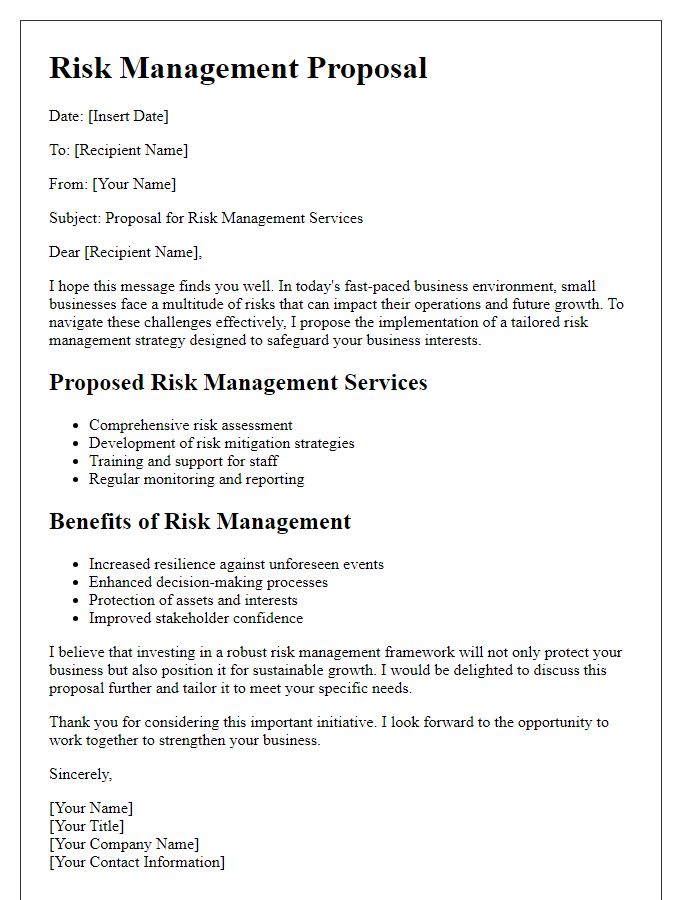Are you considering a proactive approach to safeguarding your organization against potential threats? A well-crafted risk management proposal can make all the difference in identifying vulnerabilities and implementing effective strategies. In this article, we'll explore essential components of a successful risk management proposal, ensuring you have the tools to protect your assets and enhance decision-making. Join us as we delve deeper into the strategies that can fortify your organization's defenses!

Purpose and Objectives
A risk management proposal outlines a structured approach to identifying, assessing, and mitigating potential risks that could impact an organization's objectives. The primary purpose serves to safeguard assets, maintain project integrity, and ensure sustainable operations. Identifying objectives involves establishing a proactive framework that includes risk identification processes, assessment methodologies, and implementation strategies. Specific goals may include minimizing financial losses, enhancing compliance with regulations, improving stakeholder confidence, and fostering a culture of risk awareness across departments. The strategy may also include performance metrics to measure effectiveness and revisions based on the evolving risk landscape, such as organizational changes or market fluctuations.
Risk Assessment and Mitigation Strategies
A comprehensive risk management proposal addresses potential hazards and outlines strategies for minimizing their impact on project delivery. Key components include a risk assessment framework, which identifies category-specific risks such as operational, financial, and reputational threats. The proposal highlights methods for qualitative analysis using probability and impact matrices, alongside quantitative analysis involving numerical data and statistical methods. Mitigation strategies are tailored to each risk, featuring prevention techniques, contingency planning, and risk transfer options, such as insurance or outsourcing to specialized firms. Continuous monitoring through scheduled reviews and impact assessments ensures the effectiveness of the proposed strategies, enhancing organizational resilience against unforeseen events and optimizing resource allocation in both short-term and long-term initiatives.
Resource Allocation and Budget Overview
Resource allocation and budget overview for risk management initiatives requires careful analysis and planning. The proposed budget of $500,000 for the 2024 fiscal year encompasses diverse categories such as personnel costs, training programs, and technology investments. Allocating $200,000 towards hiring skilled risk analysts, essential for identifying potential threats, ensures a proactive approach to risk management. Additionally, dedicating $100,000 for comprehensive training workshops will enhance team capabilities in risk assessment and mitigation strategies. Investment in advanced analytical tools, earmarked at $150,000, aims to improve data interpretation, enabling precise forecasting of risk impacts within various projects. Lastly, an emergency reserve of $50,000 will provide a financial buffer to address unforeseen risks effectively, safeguarding organizational stability.
Implementation Timeline and Milestones
An effective risk management proposal includes a detailed implementation timeline, outlining key milestones for monitoring and assessment. The project launch date is set for January 15, 2024, when initial risk assessments will occur, identifying potential vulnerabilities across operations. The first milestone, scheduled for February 15, 2024, involves the completion of a comprehensive risk assessment report. This will detail risks identified, prioritized from high to low impact, ensuring focused mitigation strategies. The second milestone on March 30, 2024, will mark the development of the risk mitigation plan, which includes specific actions, responsibilities assigned to department heads, and estimated costs for implementation. Stakeholder review is slated for April 15, 2024, where feedback will be integrated into the final strategy. The third milestone, May 1, 2024, involves training sessions for staff on new policies and protocols to enhance risk awareness. The project concludes with a final evaluation report on June 10, 2024, measuring the effectiveness of implemented strategies and providing recommendations for future improvements. All phases will adhere to established deadlines, ensuring a structured approach to managing organizational risks effectively.
Evaluation and Reporting Mechanism
An effective evaluation and reporting mechanism is crucial for risk management strategies. Regular assessments (quarterly reviews) can identify potential risks, measure impact (quantifying financial consequences), and ensure compliance with industry regulations (e.g., Sarbanes-Oxley Act). Utilizing advanced analytical tools (such as software like Tableau or Microsoft Power BI) enables data visualization, enhancing understanding of risk trends. Stakeholder engagement (involving teams from finance, operations, and compliance) is vital for collaborative feedback. Additionally, maintaining comprehensive documentation (risk registers, incident logs) supports transparency and accountability. Timely reporting (monthly updates to the board) ensures that key decision-makers are informed and can implement necessary interventions to mitigate risks effectively.
Letter Template For Risk Management Proposal Samples
Letter template of a risk management proposal for healthcare organizations.

Letter template of a risk management proposal for educational institutions.

Letter template of a risk management proposal for non-profit organizations.

Letter template of a risk management proposal for construction projects.

Letter template of a risk management proposal for financial institutions.









Comments